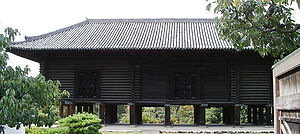

Azekura-zukuri (校倉造) or azekura is a Japanese architectural style of simple wooden construction, used for storehouses (kura), granaries, and other utilitarian structures.[2] This style probably dates to the early centuries of the Common Era,[2] such as during the Yayoi or Kofun periods. It is characterized by joined-log structures of triangular cross-section, and commonly built of cypress timbers.[3]
See also[edit]
References[edit]
- ^ "azekura 校倉". Japanese Architecture and Art Net Users System. 2001. Archived from the original on 2003-12-20. Retrieved 10 March 2021.
- ^ a b Louis Frédéric (2002). Japan Encyclopedia. Harvard University Press. p. 63. ISBN 978-0-674-01753-5. Retrieved 24 August 2012.
- ^ "Azekura-zukuri | Japanese architecture".

Well, that’s interesting to know that Psilotum nudum are known as whisk ferns. Psilotum nudum is the commoner species of the two. While the P. flaccidum is a rare species and is found in the tropical islands. Both the species are usually epiphytic in habit and grow upon tree ferns. These species may also be terrestrial and grow in humus or in the crevices of the rocks.
View the detailed Guide of Psilotum nudum: Detailed Study Of Psilotum Nudum (Whisk Fern), Classification, Anatomy, Reproduction